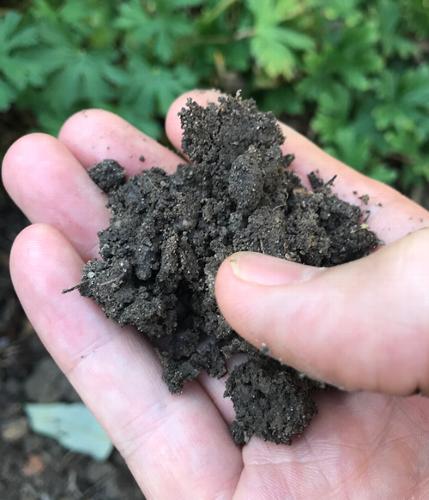Improving soil for a healthier garden.
When designing gardens one of the most satisfying aspects, whether it includes full landscaping or just border renovation, is the final planting up and fundamental to the success of planting up a new garden is ensuring the soil is going to sustain the new plants that the client is paying for.
When assessing potential design projects for plants it is not unusual for me to note (outside of a soil ph test) that the existing soil at the site is compacted and (in Essex at least) heavily laden with clay
In order to provide strong, healthy plant growth within any garden the soil must allow the plants access to light, water and good soil.
The light into any garden can vary depending on the location of trees and buildings within the site and the designer can maximise this by the careful positioning of the right plants specific to light and shade. Access to water can depend to some extent on the owners ongoing maintenance, however it is essential that the soil provides most plants with the right balance of nutrients, moisture and air. As the impact of climate change is now becoming more apparent the right plant and right soil type even becomes more important.
Soil is usually made up of two main layers this being topsoil and subsoil. The condition of the soil will be a major factor in how well the garden develops.
Perfect topsoil is a balance of three elements; clay, silt and sand. The mixture of these components can affect the drainage of the soil, the retention of nutrients and seasonal ground temperature.
Heavy Clay
For example, soil with a high content of clay has a reduced ability to drain causing it to become compacted and difficult to work with. Heavy clay soils also take time to warm up during the year meaning that spring flowering plants could be late to blossom. However, clay does have the ability to retain nutrients allowing the plants time to absorb them over time given that they do not dry out completely. It is also quite rightly argued that some plants can be tolerant of clay soils but in truth these plants will often perform better in well-structured soils.
Silt
Silt is made up of tiny fragments of rock eroded over time by water and ice that have been washed into valleys via rain fall, rock falls, ground movement or wind. The broken particles end up in rivers where they come into contact with more rock, effectively sand blasting against the rocks, grinding them up into smaller particles until the constituent components can be considered silt. As the rivers then burst their banks during heavy rainfall and lowlands become flooded, the silt ends up spread across the land. This was established in the very first recorded gardens in ancient Egypt, where silt provided the extremely fertile component of soil.
Sand
Whilst all plants need water in varying degrees most do not do well if they are sitting in it. Sand, whilst lacking in nutrients and structure, when combined with clay and silt in the right measure provides the drainage structure in soils that is essential for plants to thrive.
It is widely understood therefore that good soil structure is achieved when no component is greater than 50% with optimum levels being 20% Clay, 40% Silt and 40% Sand.

Water and Air
It is highly likely that the perfect soil scenario for planting may not be available in every garden and as mentioned earlier, plants also require water and air.
The perfect loam, air and water combination would be made up of 50% soil, with a 25% moisture content and 25% air. Water and air reside in pockets throughout the loam mixture, which plants can easily access. Compacted clay soils can reduce the air component to just 5% and the water component can rise dramatically. This usually has a very negative affect on most plants, as mentioned earlier plants need water but will suffer if sitting in waterlogged ground.
In order to improve the drainage of clay soils grit, sharp sand or some form of soil improver should be dug into the soil with the addition of well-rotted and coarse farmyard manure. This will effectively break up the clay and allow water to drain and air to circulate.
For sandy loam soil the problem is the reverse in that the objective is to ensure the soil holds more water. This can be achieved by again adding 75 to 100mm of well-rotted farmyard manure or compost.
To gain some understanding of what type of soil you have in your own garden you can carry out this simple test.
1/. In a small garden take a full ‘spades depth' soil sample from different points around the garden.
In Larger gardens you should break the collected samples down into areas specific to the site, such as front garden and back garden, as large plots may vary slightly.
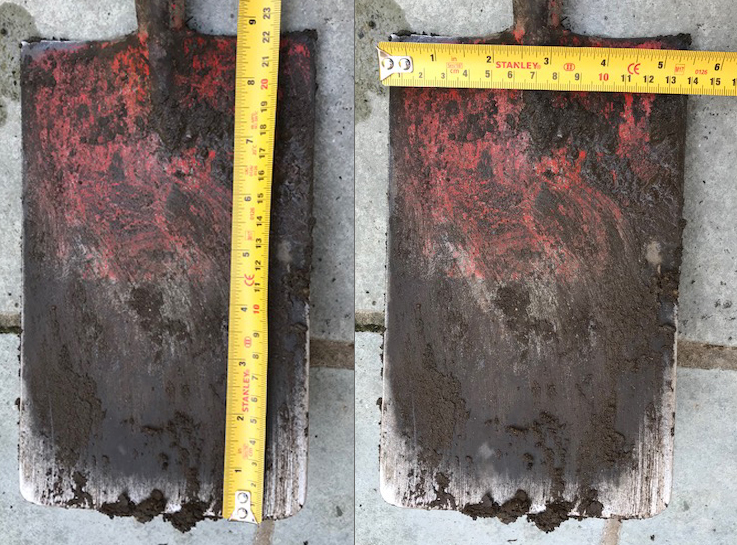
2/. Put all the collected soil in a container (a garden trug is really useful for this). Remove any unwanted stones and roots as much as practical.
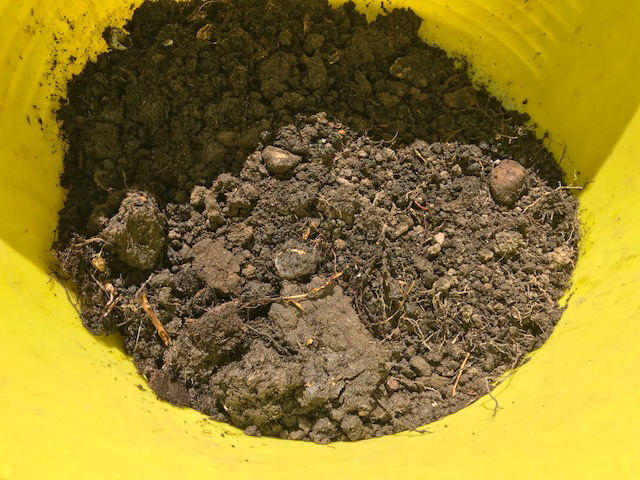
3/. Then collect a sample in your hand and roll it into a ball, roughly the size of a golf ball.
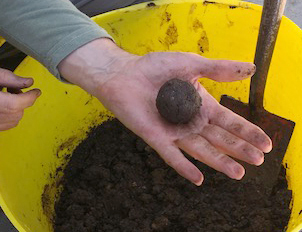
4/. Holding the ball of earth in one hand and using your thumb on your other hand to slowly squeeze the sample
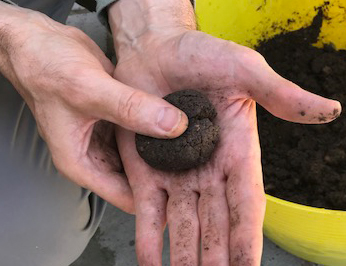
5/. If the sample breaks up into pieces and starts to fall away the soil should be considered a sandier soil.
If the soil is ‘sticky' and holds together as a complete disk with limited cracking, then it is likely the clay content is high.
If it roughly holds together with some cracking (as shown in the image) then it suggests that the content of sand, clay and silt is in reasonable balance.
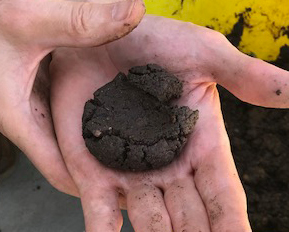
This test can be completed again in a slightly different way by squeezing the ball between your thumb and forefinger, with the same analysis.
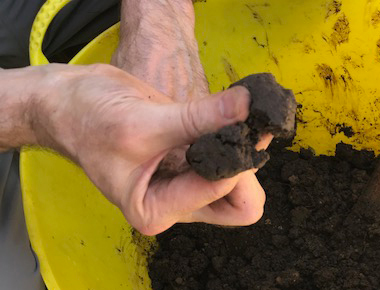
Whilst I accept this isn't scientifically conclusive, it will help you gain a greater understanding of the make-up of your soil and what remedial action (if any needed) you can take.
As mentioned earlier, the larger your garden the more samples you should take and its worth breaking the samples taken into areas, as there may be variation across the whole garden, especially where level changes play a part.
One final point I should stress if you are looking to improve your soil by adding medium of any sort, it is wise to properly dig the compost into the existing soil. I've often seen landscaping companies just lay the compost or soil improver on top of the soil saying "the worms will turn the compost in". Personally I think that stretches the remit of earth worms. The image below left shows ground recently dug over revealing a commercial compost that was laid like a thin mulch 2 years previously still sitting on top of a heavy clay soil, having given the soil minimal benefit in drainage or air circulation. If you're going to mulch it should be laid 75 to 100mm thick. If you're looking to improve the soil structure 'dig the medium in'.
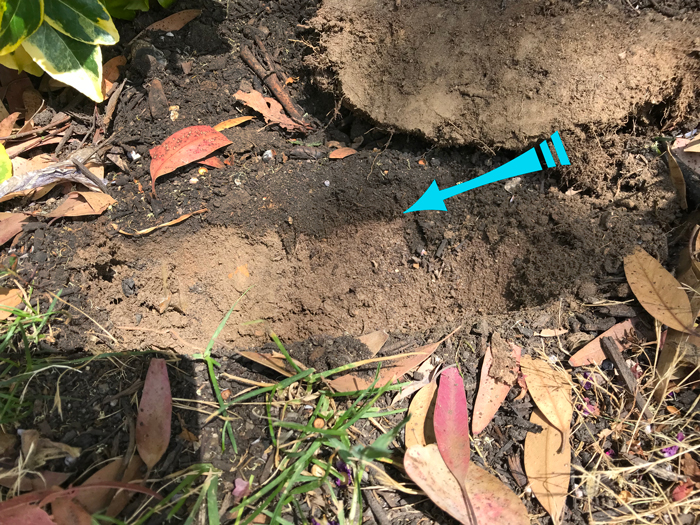
The important thing to remember is, if you're going to spend lots of money on plants, the amount of time and money spent on your soil will be “make or break” in how well the plants flourish. As I once read:
"Don't put a £20 plant into a 0.20p hole"

